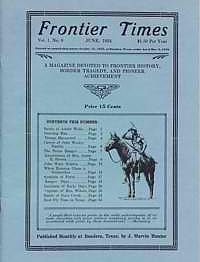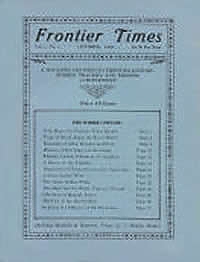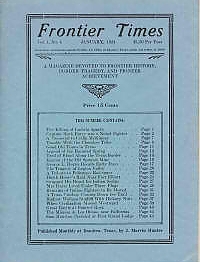By using our website, you agree to the use of cookies as described in our Cookie Policy
Magazines & Instant Downloads
Vol 01 No. 09 - June 1924
The Battle of Adobe Walls.
Olive K. Dixon.
The location of these much talked of battle grounds is in Hutchinson county, Texas, on the north side of the Canadian river, ten miles east of the town of Plemons and about three quarters of a mile south of the old Turkey Track ranch head-quarters. At this place was enacted one of the most stubborn end successful fights ever made by a limited number of white men against an overwhelming number of hostile Indians.
Further Mentions: a man named A. C. Myers, who owned a store in Dodge, the head of Moores Creek, following the river down to Adobe Walls Creek, a general store, owned by A.C. Alyers, a blacksmith shop run by Thomas O'Keefe and a saloon and mess house owned by James Hanrahan, Billy Og, William Dixon, Billy Tyler, who was shot in the beginning of the fight, the two Shadler brothers, who were surprised and killed in their wagon on the north side of the stockade
The Dancing Man of the Navajoes.
Story of "The Dancing Man." of the Navajoes. Other Indian, tribes have been subdued by bloodshed and driven into peaceful pursuits at the point of the bayonet, but the Navajoes, the bravest and most intelligent of the red men, were lured into loyalty by a trick. To this day the remnants of this once-powerful tribe pin, their faith to a shabby old scare-crow preserved in a Pueblo mission, under the belief that the "The Dancing Man" foretold during many generations had visited them and stopped bloody conflict. The trick was never discovered.
Further Mentions: Col. Ed. V. Sumner, of the Second Dragoons, Ft. Defiance, Major Backus.
Fort Davis Troops Massacred by Apaches.
Capt. A. J. Sowell. Fort Davis, county seat of Jeff Davis county, is situated at the foot of the Davis mountains and named for Jeffer1son Davis, president of the Southern Confederacy. At the time of the massacre of the Fort Davis troops, which was in the late 1870's, a company of negro troops was stationed there. It was commanded by a white captain and lieutenant. This was the time when the Apache Chief Victoria, and his warriors were raiding and committing depredations along the border, both in Texas and Mexico. This is the account of a terrible slaughter that occurred in the mouth of the Green River canyon, where troops were ambushed and ruthlessly slaughtered by well entrenched Apaches.
Further Mentions: Ojinaga, Valentine, ranchmen George Newton and Otis Fenley, Captain Gillett's ranch, Captain George Baylor and Lieutenant Nevelle
More About the Career of John Wesley Hardin.
By James Hatch.
Further details are provided about the enigmatic frontier figure by a man who claims, "I probably knew as much about John W. Hardin as any other Texan. I witnessed the tragedy when he killed Morgan at Cuero, and I kept pretty well up with his whereabouts and doings after I first made his acquaintance in Cuero in 1874, shortly after he came to DeWitt county and attached himself to the Taylor crowd.
Further Mentions: John Warren Hunter., the James Hatch home ranch being located on the Agua Dulce, a tributary to Big Chocolate Bayou twenty miles from. Indianola and six miles from Port Lavaca., the G. W. T. & P. Railroad, John Swartz, a butcher of Indianola, Hatch & Swartz's market, John Swartz, Jim Taylor, Neil Bowen., the Huntsville penitentiary.
THE TEXAS RANGER (An Old Song)
We saw the Indians coming, we heard them give their yell;
My feelings at that moment, no tongue can ever tell;
We saw their painted faces, their arrows round us hailed;
My heart, it sank within me, my courage almost failed.
I thought of my old mother, who in tears to me did say:
"To you, they are all strangers, with me you'd better stay."
I thought her weak and childish, and that she did not know,
For I was bent on roaming, and I was bound to go.
Come all ye Texas Rangers, where ever you may be;
I'll tell to you a story of what happened unto me;
My name is nothing extra, so to you will not tell,
But here's to all good Rangers-I'm sure I wish you well.
When at the age of fifteen years, I joined the royal band,
We marched from San Antonio unto the Rio Grande;
And here the Captain told me -perhaps he thought it right-
"Before you reach the station boy, I'm sure you'll have to fight."
We battled full five hours before the fight gave o'er;
Three hundred noble soldiers lay weltering in their gore…etc, etc
Experiences of Mrs. Annie E. Brown.
Mrs. L. Hicks, Tarpley, Texas.
This is a beautiful, but at times frightening account of pioneer life by a woman who lived it. Annie, who was born in Thibadeauxville, La Fourche Parish, Louisiana, in 1838, became Mrs. Brown on November 25th 1859. She and her husband, Mr. Brown sought to make the journey to California to settle there, but were hindered, so they settled in TX, in Devine, in southeast Medina County, near the home of Bigfoot Wallace, with whom they became fast friends. They later settled in Bandera county and she engaged in profession as a pioneer nurse and even practiced in Europe for a time.. This is truly great first-hand history.
Further Mentions: Eagle Pass, Souse Creek, four miles below Castroville, a family named Berpert in San Antonio, Mr. Christian Santleben, Sibbley's Brigade, Kincheloe Prairie, a man named Katisky, Trumbull's committee, Mr. Woodward, who owned a place on the Medina, eight miles from Castroville, a boy Isaac Galbreath, Mrs. Reath of Hondo., Mr. Whitley and Mr. McCrey and their two sons, Black Creek, from a lawyer, Russel Howard, of San Antonio, Mr. Dave Lewis, Barnes Bluff, near the old Rothe ranch, Mr. Lewis' home on Williams Creek, Deputy Sheriff Phillips, Seco Pass, Grandpa Cazey, Sam Cazey, Mr. Hudspeth, Ellis, Mr. Ross, who in turn sold his place to Mr.Tucker, the Alaverick ranch, the Mavericks, old Dr. Cupples, Dr. Ferdinand Herff, SK., Dr. Adolph Herff, Dr. Barnitz, Dr. Kingsley, Dr. Jones, Dr. Palmer, Williams Creek, Mr. E. H. Terrell, Mr. George Maverick, a brother to Mrs. Terrell.
John Ware Relates Thrilling Experiences.
By Chas. T. Carlton, Bandera, Texas.
Account of John Ware, whose father, Captain William Ware. who was in the battle of San Jacinto, came from the Cibolo, east of San Antonio to Fort Lincoln, August 17, 1852, when just thirteen, years old. His father turned loose his 750 head of cattle and went into camp at what was known for years as Waresville. This is the story of his incredible life on the early frontier, and it is excellent early Guadalupe Co. history.
Further Mentions: Jeff Mills, Jim Davenport, Henry Robinson and John Davenport, Aaron Anglin, Uncle John Davenport and Jim Dawn, Thompson, Robinson, Uncle John Findley, sister Eliza. Laborn Kelly, Cris Kelly, Jasper Wish, Bob Thompson, Roll Miller, Leek Kelly, Reinhart Prairie, Wilson O'Bryant, Bear Creek, John Leakey, Delar Webster, Henry Robinson and Sebe Baramore, Ranchero Creek where Captain Davenport lived., R. P. Kelley, a merchant of El Paso, Fort Inge. W. W. Black, of Black & Stratton, J. M. McCormack, county clerk, the Westfall ranch, Uncle John Findley, Gid Thompson and W. W. Black., Neonan Patterson, Old Dutch Dillard
When General Houston Chose a Godmother.
By D. M. Clower.
Account of Mr. Charles A. Sterne of Palestine, born in Nacogdoches in the year 1830, the oldest Mason under the jurisdiction of the Grand Lodge of Texas (as of 1924). He was made a Master Mason in Euclid Lodge No. 30 at Rusk, Texas, in 1852. He is also a life member of Galveston Consistory No. 1. He tells account of after the battle of San Jacinto, General Houston being wounded, went to New Orleans to recuperate. After getting well, he came back to Texas, first stopping for a time at San Augustine, and later coming to Nacogdoches, where he called on Sterne’s father and mother. When he met the mother he embraced her Most affectionately, addressing her as "'My dear godmother." This declaration had profound significance in the further career of Houston – the details are recorded in the story.
Further Mentions: He boasts of being Ancient and Accepted Order Scottish Rite of Free Masonary. He served as trustee and secretary of the Palestine school board for 30 years, the John H. Reagan Camp of Confederate Veterans of Palestine., Colonel John H. Brunet, for 20 years managed and conducted the principal hotel of Palestine. Colonel John S. Roberts, Mrs. Rosine Ryan, of Houston, Texas
Symbols of Force and Peace in History of Texas.
Mentions the noble collection of TX historical artifacts that are at rest in the capitol at Austin.Tomahawks and pistols, foreign treaties and domestic state papers, seals of mighty soverigns and signatures of plain republicans, all snuggle side by side in the vaults of the treasury department, at Austin, finally at rest and at peace with each other after the conflict of races out of which the destiny of Texas was fused. The pistols and tomahawks were once the property of Stephen P. Au~4tin. They are held in a safe in the treasury vault, but are in control of the state library, which by the law is the depository for all such historical property of the state.
Among the treaties are those between the Republic of Texas and France, Holland and England. They bear signatures of the rulers of those countries and the presidents of Texas. With them is that immortal letter written by Travis from the ill-fated Alamo in which he penned those burning words that have always been a high motto to the sons of Texas, "I shall never surrender nor retreat. " The very paper which passed through the fire and the hell of the Alamo is here in this safe...
Incident of Ranger Days.
By Taylor Thompson.
Speaks of bloody encounter with Indians in the vicinity of what is now Hebronville, a station on the Texas-Mexican railway, though there was no railway there in those days. It was in what became a part of Webb county. In the autumn of 1864, Indians were driving a large bunch of stolen horses and thus pursuit followed in strong hopes of being able to overtake them before they had gone very far. The trail led in a northwesterly direction, passing between Uvalde and Eagle Pass to the point of the conflict.
Further Mentions: Fort McKavett, Macedonia Dalgado, the head draws of Devil's river, corporal, Justo Rodriguez, Captain Jack Hayes, Miguel Martmores
Relates Interesting Incidents of Early Days.
Hon. A. J. Rose.
"Forty-five years ago the first day of this month (September), I, with my wife and two children, left our home in Missouri for Texas, our conveyance being a mule team. We reached Travis county in the 28th of October, 1856. Before leaving Missouri I was told that it was too dry in Texas to farm successfully. I stated to those who had informed me of the aridity of Texas, that it was my intention to find a tract of land which could be irrigated. In January, 1860, I purchased a desirable tract in San Saba county, about fifteen miles above the town of San Saba on the San Saba river. Here I found the place-a little river gushing out of the side of the mountain which afforded all the water I needed, and some to spare, My anticipations were more than realized, as I could raise on an average 75 bushels of corn and 250 bushels of potatoes to the acre. During the war between the states my place acquired the title of little Egypt, due to the fact that people came from far and near for bread and generally found it. Women whose husbands were in the army came for food, and none were ever turned away empty handed, money or no money. I do not say this boastingly. Under an order from the war department, men who had families were placed on frontier service, to protect the women and children from the ravages of the Indians, who were in the custom of visiting this section every moon for the purpose of stealing horses and sometimes cattle, in addition to scalping white men and carrying away women and children. The time allotted me will not permit me to relate but few of the incidents which have come under my personal knowledge during the eight years I lived in San Saba, county." One afternoon a neighbor came galloping up to my house with the information that a band of Indians were rounding up horses on Dry Creek, a few miles north...
Further Mentions: Beardy Hall, so called from his long beard., W. Murray, Ed King, with Captain Williams, Mr. Todd of Alason, Ben Lynn, Richland creek., Richland Springs, Will Miller and A. W. Morrow, from McCulloch county, James Sutton, Sloan and Armantrout, Dorans, Brady's Creek
The Capture of Mrs. Wilson.
In the spring of 1853 a party of immigrants started from Northeast Texas overland to California. There were ten or twelve men, one lady and two little boys, aged ten and twelve years. The lady, Mrs. Wilson, was a young bride, formerly Miss Jane Howard, born in Missouri but reared in Texas. The little boys, Hugh and --, were brothers of her husband, whose father, Mr. Wilson, Sr., was also in the, party. An excerpt of the tragic account: "She was treated with great brutality by the brutal savages, who traveled over the plains and finally along a trail for two or three weeks. She was compelled repeatedly to mount wild horses or mules and as often thrown, to the ground, greatly to the delight of the wild brutes. Finally, they compelled her to walk until, by continuous ill treatment, she was greatly weakened. On arriving at a spring, on the borders of a desert, they killed wild game in some quantity and compelled her to cook the meat for a three days' trip over the waste before them. Allowed her to prepare some for herself and told her to start ahead on the trail before daylight. In gathering wood not far from the spring she had discovered a stump of a large cottonwood tree seven or eight feet high, and in stripping the bark from it, found that it was hollow. Starting quite early on the trail she traversed about three miles; then coming to a locality covered with tall grass, she determined to make an effort to escape. When deemed safe she sought and found the hollow stump, climbed to its top and entered it retaining the meat she had cooked. The presumption is that the Indians started after daylight, traveled many miles before they realized that she had escaped and probably made no pursuit. She remained in the stump by day and went to the spring at night till her meat was exhausted. Then she found food in the raw flesh of a few frogs about the spring, two or three terrapins, besides a snake, of course without cooking, as she had no means of making a fire…"Further Mentions: Mr. A. A. Pittuck, a worthy, intelligent and honorable employee of Texas Farm and Ranch, Gov. Merriwether, Mr. Hart., Ft. Phantom Hill, Mrs. Wilson, Hugh Wilson, Mrs. Smith, the wife of the Baptist missionary, the store of Webb & Kingsbury
The Battle of Dove Creek.
Judge I. D. Ferguson, Denton, Texas. Very detailed first-hand account of this bloody and sad confrontation which occurred in the Fall of 1864, under McCord's regiment, the command of Col. J.B. Barry. They were stationed on the frontiers with head-quarters at old Fort Belknap. Indians in large numbers had broken up the settlements from Fort Murry down, to Belknap. Capt. Jack Curenton of Palo Pinto county, with his company of frontier scouts, had discovered a large deserted Indian camp in the big shinnery or the Clear Fork of the Brazos in Jones county, near old Fort Phantom Hill. The fight occurred on the banks Dove Creek, a tributary of the South Concho river;
An excerpt: "Finally the Indians drove us again from this place and the rout from this branch became a wild-panic like that of stampeded cattle. Order could not be restored; officers seemed to lose control over their companies; they yelled themselves hoarse trying to get the men to halt and make a fight and drive the Indian's back; men on wounded horses begun to drop in the rear, soon to be overtaken and killed. Among the number was Jim Gibson of our company, and myself. Both of our horses had been wounded. It was but a very short time until Mr. Gibson was killed, and it appeared that I was to be the next in order as it did not seem possible that I could escape death. I was getting far behind the retreating column and the Indians were getting close to me. A stream of singing bullets clipping my clothing, the air seemed alive with flying lead. My hopes had fled, and I became resigned to my fate. All fear and excitement passed away with my hope of safety and left a train, of thoughts passing through my mind faster than the speed of time; I wondered how I would feel when the deadly missile came crashing through my brain. I thought of home, and what the people would say about me when I was gone; I imagined that after death, the wolves would sneak up and gnaw my bones, and the wild buffalo would click their hoofs against my dry skull and scare the crickets out of my eye sockets where they had hid away to sing their evening songs. I thought it would be better for me to be killed, as I was only a boy, and had no cares of my own nor none, to care for me. That it would better be me than those who had no families to care for.
Just as these thoughts were trooping through my brain, I saw the panic stricken column checking up and a little man wheel his horse and with a, loud voice say, "Here boys, here, follow me, let us save that boy's life!" It was J. 0. Alexander of our company, God bless his noble name; to him I owe my life. He came charging back, followed by our own company and also Foycett's company, with the old gray headed commander leading them; and in u minute the whole command had rallied and were coming flying back, screaming and shooting as they came. They drove, the Indians back and we planted ourselves on a ridge of prairie to stand and fight till every man was dead. We held up our hands and all took an oath that we would stay there as long as a man was alive, and that there would be no more running away. Even the wounded men came back and took the oath to die with us. It was now sun down, and the Indians had surrounded us, shooting at us from nearly every direction…"Further Mentions: Col. J.B. Barry, Rowland's, Cook's, Foycett's, White's, Thompson's and Whiteside's companies, Col. Barry, Jack Curenton's company and 400 militia from Erath, Brown, Comanche and Parker counties under the command of Capt. Totten, Fort Chadbourne, 'Maj. George H. Thomas, Capt. Mulkey, the Ranger Spring where Water Valley now stands., Capt. Barnes, Capt. Collier, and Capt. Gillentine, Jim Gibson, Bill Bowland, Dave Argo, Louis Willey, Bailey, Mr. Miles Bond, "Bud" Clark, Lieut. Giddian, Sergeant R. C. Porter., Spring Creek, Company C, Baxry's Rangers; John Chisum's ranch at the mouth of the Concho., J. M. Waide, of Totten's militia, Capt. White's company, Little Jim Dyer, Camp Colorado, Curley Hatcher, Captain Maltby
HEEL-FLY TIME IN TEXAS.
By John Warren Hunter.
During Civil War, certain individuals, know as the Home Guard were enlisted into service to force any able-bodied man into conscription. They exercised their "authority" in a way that made them odious to the populace of Texan citizenry, in the words of Mr. Hunter, "Such was the high-handed, outrageous conduct of the Home Guards, not only in a few sections but throughout the state generally, that they obtained the sobriquet of "Heel-Flies" on account of the similarity of their course to the tortuous proclivities of a pestiferous insect so well known to cattlemen all over Texas. No class of men, or rather striplings, in our great state has ever been the recipient of more righteous contempt heaped upon them by patriotic men and women of Texas than these Home Guards" This is great Civil War era TX history. Lengthy, detailed and engaging account mentioning further: the Somers League, Ciriaco, Dr. Bellah's, Mayo's Mill., Wylie Clampit, Gollihar boys, Tate' and Colbath, Henry Dunn, a man by the name of Jennings, Joe Tate., the Harless school house, Clarks Creek settlement., Mrs. Cox, the Colorado Home Guard, Wallace Mill, the town of Hope, an old German by the name of Hample, Mr. Kendrick, Olivia Chandler, Wm. Gafford., J. A. Gafford of Silver Valley, the Clinton company, the Somers thicket, Mr. Harper, Mr. Hamersley, Mr. Cherry, Mr. Cherry's son, Rob, . Mr. Walton, Mr. Inman, El Zarco., San Patricio, Lago Cayman, or Lake of the Alligator, King's ranch., a ranch occupied by a Dr. Cox, a brother to Rev. Ivy H. Cox, a pioneer and Methodist preacher in the West Texas Conference, . Old Fort San Miguel, Jack Cook, Mr. Stanfield, L. B. Cox., Rancho Los Olmes, Benevides' regiment of cavalry, C. S. A., Rancho Davis; General, Menez, Mr. Pierce.
$4.95
‹ Back








